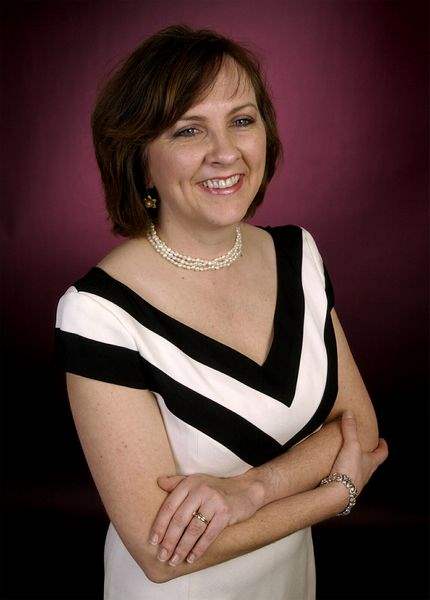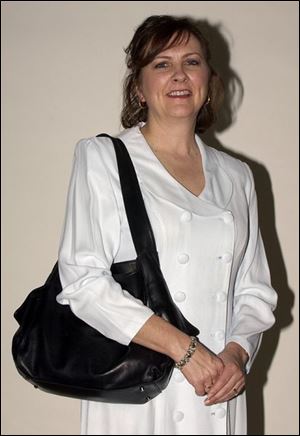
Picture this: You can look good for the camera
5/16/2004
Jennifer Brown improved her chances of getting a good photo of herself by paying attention to hairstyle, makeup, and clothes.
Morrison / Blade photo

Jennifer Brown improved her chances of getting a good photo of herself by paying attention to hairstyle, makeup, and clothes.
The greenest photographer soon learns that when the camera comes out, some folks duck for cover, claiming they're camera shy or don't photograph well.
But what they may not know is there are ways to maximize the chances of getting a good photo. So if you're among those dreading graduation and wedding season (and driver's license renewal time), we called on professional models and photographers, and pulled a few tricks out of our own bag, to help in your quest for a good photo of yourself.
It may go without saying, but we'll say it anyway: a fantastic photo starts with good grooming and an outstanding outfit. If you're stuffed into a suit or collar that's too tight, or have stringy hair because you overslept, your discomfort will come through in the image.
Once you take care of the physical details, tackle the mental issues.

Jennifer Brown changed her look for the camera.
"If people feel good, feel confident, they're going to look great," said Bill Hurter, editor of Rangefinder and Focus on Imaging photography magazines. "It doesn't even matter what they look like."
So if you've always put a hand in front of your face at the sight of a camera, it's time for a new attitude.
"People fight it instead of saying, 'I'll go through with this and smile,' " said Craig Alesse, head of Amherst Media Inc., which publishes photography books, and author of Don't Take My Picture! (1998, Amherst Media).
"To me, that makes it worse," Mr. Alesse said, confessing that he too does not enjoy being photographed. But "I cooperate with them rather than complain about it."
Overcoming self-consciousness isn't easy, but it is possible - and the result, a relaxed and happy face, is worth it. After her speech May 7 in Oregon, supermodel Kim Alexis said her favorite tricks involve music and humor.
"I hum," she said. "You've got to not have that fake look. So you don't just freeze your face. You sort of have to lighten your eyes. It's OK to have the same look a couple of times, but there are people, they see a camera, and they're like," and she made a face with a horrible, artificial smile, "like a little kid."
"So act natural. Humming helps me act natural."
Mr. Huter agreed. The "plastic smile" always backfires on everyone involved.
"It looks cartoon-y. It's a picture everyone will hate," he said.
So how to act natural in an artificial setting?
"Make yourself really laugh from the inside," Ms. Alexis said. "It's more natural. Even if it might be stupid at the moment. You're going to keep that photograph. I remember for my driver's license photo, I had my husband and my ex-husband there for some reason. And they're both looking at me like I'm nuts. And I said, 'No. Everyone's going to look at this driver's license, and only you two idiots are going to realize that I might have looked like a stupid idiot for 10 seconds.'
"But that's an important picture! You've got to do what makes the picture nice, not what people around you [expect.]"
And finally, be aware of what you're doing, Ms. Alexis added. Has your hair flopped into your eyes? Are you picking at your fingernails in a shot that will include your hands?
Also consider your stance, Mr. Hurter said. Instead of facing the camera squarely, which adds pounds, angle yourself slightly and put your weight on your back foot.
Other tricks need the help of a sympathic photographer.
If you're being photographed inside, use light streaming through a window, Mr. Alesse said.
"It's the most flattering light around," he said. "Where you're being illuminated by diffused light, it's always a wonderful setting for photographs."
If you're among the 65 percent of American adults who are overweight or obese, and you're insecure about your extra chin, having a photo taken can be stressful. But there is an easy way to skirt the double-chin issue: ask the photographer to stand above you. Raising the camera diminishes a thick neck, Mr. Hurter said. And this camera angle also minimizes the subject's lower body.
This positioning can be accomplished by having the subject sit on the ground, or having the photographer stand on a handy ladder, chair, or picnic table. It's also an effective way to do a group photograph - no need to put the shorter folks in the front, lots of people can crowd into the frame, and the unusual angle makes the image distinctive and a little whimsical.
Can't avoid being photographed at eye level? Tilt your head down a bit and don't wear a white shirt; the light reflects up, highlighting that extra flesh.
And if the camera has a detachable flash unit that the photographer can hold above his head, ask him to do so. The resulting shadow flatters, and as an added bonus, using a flash above eye level eliminates "red eye" in color photos.
Finally, if your photographer has a sense of humor, ask him to tell a joke while he takes the photo rather than make you say "cheese."
"Say 'cheese,' and it's going to be cheesy," Mr. Hurter said.